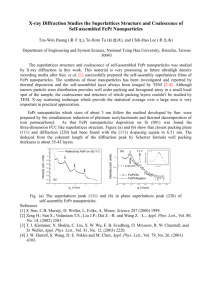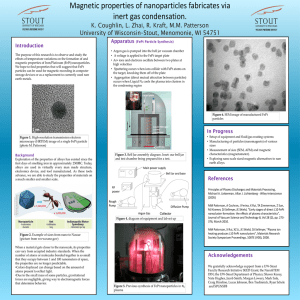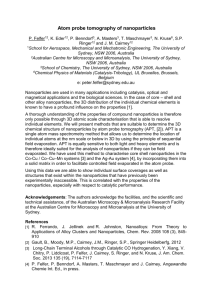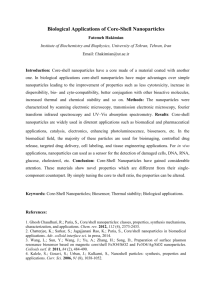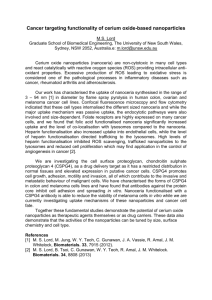Supporting Information - Springer Static Content Server
advertisement
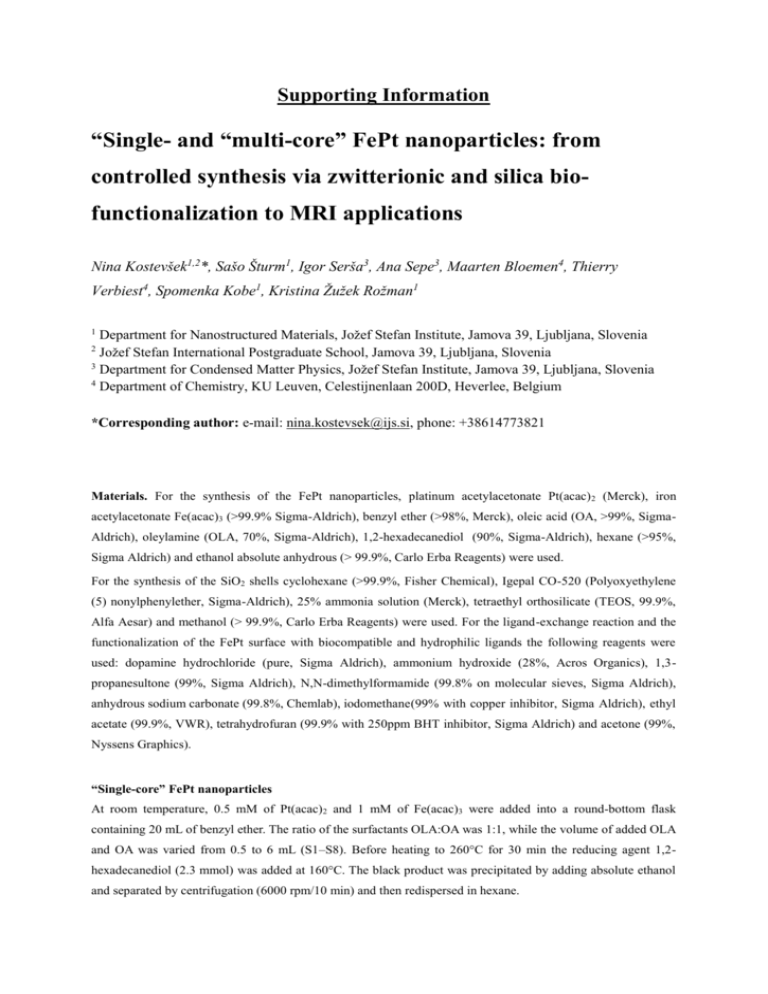
Supporting Information “Single- and “multi-core” FePt nanoparticles: from controlled synthesis via zwitterionic and silica biofunctionalization to MRI applications Nina Kostevšek1,2*, Sašo Šturm1, Igor Serša3, Ana Sepe3, Maarten Bloemen4, Thierry Verbiest4, Spomenka Kobe1, Kristina Žužek Rožman1 Department for Nanostructured Materials, Jožef Stefan Institute, Jamova 39, Ljubljana, Slovenia Jožef Stefan International Postgraduate School, Jamova 39, Ljubljana, Slovenia 3 Department for Condensed Matter Physics, Jožef Stefan Institute, Jamova 39, Ljubljana, Slovenia 4 Department of Chemistry, KU Leuven, Celestijnenlaan 200D, Heverlee, Belgium 1 2 *Corresponding author: e-mail: nina.kostevsek@ijs.si, phone: +38614773821 Materials. For the synthesis of the FePt nanoparticles, platinum acetylacetonate Pt(acac) 2 (Merck), iron acetylacetonate Fe(acac)3 (>99.9% Sigma-Aldrich), benzyl ether (>98%, Merck), oleic acid (OA, >99%, SigmaAldrich), oleylamine (OLA, 70%, Sigma-Aldrich), 1,2-hexadecanediol (90%, Sigma-Aldrich), hexane (>95%, Sigma Aldrich) and ethanol absolute anhydrous (> 99.9%, Carlo Erba Reagents) were used. For the synthesis of the SiO2 shells cyclohexane (>99.9%, Fisher Chemical), Igepal CO-520 (Polyoxyethylene (5) nonylphenylether, Sigma-Aldrich), 25% ammonia solution (Merck), tetraethyl orthosilicate (TEOS, 99.9%, Alfa Aesar) and methanol (> 99.9%, Carlo Erba Reagents) were used. For the ligand-exchange reaction and the functionalization of the FePt surface with biocompatible and hydrophilic ligands the following reagents were used: dopamine hydrochloride (pure, Sigma Aldrich), ammonium hydroxide (28%, Acros Organics), 1,3propanesultone (99%, Sigma Aldrich), N,N-dimethylformamide (99.8% on molecular sieves, Sigma Aldrich), anhydrous sodium carbonate (99.8%, Chemlab), iodomethane(99% with copper inhibitor, Sigma Aldrich), ethyl acetate (99.9%, VWR), tetrahydrofuran (99.9% with 250ppm BHT inhibitor, Sigma Aldrich) and acetone (99%, Nyssens Graphics). “Single-core” FePt nanoparticles At room temperature, 0.5 mM of Pt(acac) 2 and 1 mM of Fe(acac)3 were added into a round-bottom flask containing 20 mL of benzyl ether. The ratio of the surfactants OLA:OA was 1:1, while the volume of added OLA and OA was varied from 0.5 to 6 mL (S1–S8). Before heating to 260°C for 30 min the reducing agent 1,2hexadecanediol (2.3 mmol) was added at 160°C. The black product was precipitated by adding absolute ethanol and separated by centrifugation (6000 rpm/10 min) and then redispersed in hexane. “Single-core” FePt nanoparticles produced via seed-mediated growth For the first step in the synthesis the experimental procedure for sample 7 was used (volume of OLA and OA is 4 mL). After the reaction the mixture in the first step was cooled to room temperature, in the second step, half of the initial volume of the metal salts was added and the same heating regime (260°C/30 min) was used as in the first step. After cooling to room temperature the black product was precipitated by adding absolute ethanol and separated by centrifugation (6000 rpm/10 min) and then redispersed in hexane. “Multi-core” FePt nanoparticles Samples were prepared by changing the OLA:OA ratio while all the other parameters were kept the same as in the case of the “single-core” FePt NPs synthesis. The OLA:OA ratio was varied between 0.08 and 0.75. The volume of OLA was constant (6 mL), while the volume of OA was varied: 0.5 mL, 1 mL, 2 mL, 3 mL and 4.5 mL (S10–S14). An additional two experiments were performed where only OLA (6 mL, S9) or OA (6 mL, S15) was used. SiO2-shell formation FePt “single-core” or “multi-core” nanoparticles (20 mg) were added to a mixture of 170 mL of cyclohexane and 8 mL of surfactant Igepal CO-520. Then 1 mL of 25% ammonia solution and 0.2 mL of TEOS (tetraethyl orthosilicate) were added drop-wise and the whole mixture was vigorously stirred at room temperature for different reaction times (6, 12, 18 and 24 h) and deposited on TEM grids, and subsequently the thickness of the SiO2 shell was measured. In order to induce positively charged aminopropylsilane groups on the SiO 2 surface 5 mL of 12 mM APTES (>98%, Merck) solution (water:ethanol=1:3) was added to the suspension of the FePt/SiO 2 nanoparticles. The reaction mixture was stirred at 80°C for 3h before cooling to room temperature. Any excess of APTES was removed with five cycles of centrifugation (7500rpm/20min) and redispersion in water. Successful functionalization with APTES can be monitored by measuring the zeta-potential on the surface of the FePt/SiO2 NPs in water. Synthesis of ZDS ligand Dopamine hydrochloride (2.26 g, 12 mmol) was dissolved in 200 mL of ethanol in a flask, equipped with an Ar balloon. Ammonium hydroxide (832 μL, 6 mmol) and 1,3-propanesultone (1.14 mL, 13 mmol) were added and the mixture was stirred at 50°C for 16 hours. Dopamine sulfonate precipitates as a white solid, which was collected by centrifugation (10000 rpm/5 min) and washed three times with ethanol. The product was collected as a white powder (1.581 g, 40% yield). In the next step dopamine sulfonate (0.656 g, 2 mmol) was dissolved in 100 mL of dry N,N-dimethylformamide (DMF) and anhydrous sodium carbonate (0.508 g, 4.8 mmol) was added. After purging the system with argon gas, iodomethane (4.4 mL, 70 mmol) was added and this mixture was stirred for 16 h at 50°C. The mixture was filtered and the solvent was removed using a rotary evaporator. A mixture of DMF (4.4 mL) and ethyl acetate (45 mL) was added to precipitate the zwitterionic dopamine sulfonate, which was collected by centrifugation (10000 rpm/5 min). This procedure was repeated three times to finally obtain a white powder (364 mg, 51% yield). Ligand exchange reaction Water-soluble “single-core” and “multi-core” FePt nanoparticles were achieved by a ligand-exchange process, where the nanoparticles were functionalized with the ZDS ligand using the following procedure. FePt nanoparticles (12 mg) were dissolved in 12 mL of tetrahydrofuran and the zwitterionic catechol was added (18 mg), dissolved in 1.2 ml of MilliQ water. This mixture was sonicated for 3 hours in an ultrasonication bath (Branson 5510). To purify the particles, 2 mL of MilliQ water and 10 mL of ethyl acetate were added to induce phase separation. The functionalized particles remained in the bottom aqueous phase, which was collected. This layer was washed three times with 10 mL of ethyl acetate to remove any residual tetrahydrofuran. A small volume of acetone was added to the aqueous layer (until turbid), which was subsequently centrifuged (10000 rpm, 5min) to collect the nanoparticles. These functionalized nanoparticles were dissolved in MilliQ water.
